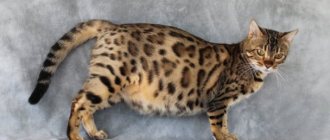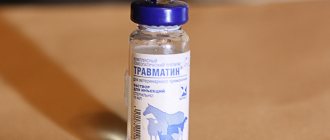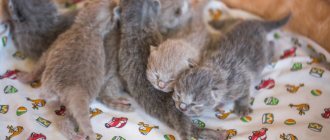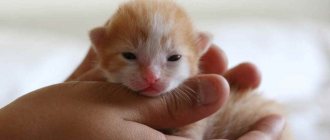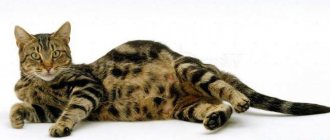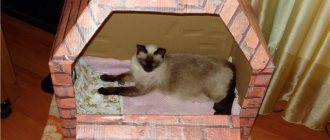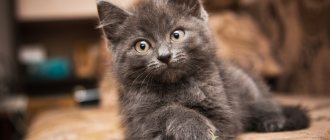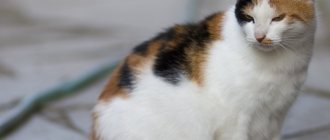At what age do cats give birth?
From 7 months, the cat begins to be interested in the opposite sex and becomes sexually mature.
If you want to get healthy offspring, veterinarians advise breeding the animal during its second heat. Cats can give birth until old age, but pet owners should stop their pet’s sex life in time so that the quality of the offspring and the health of the cat are not affected. After all, when abusing a cat’s ability to give birth, people often think only about their own wallet. Thus, to avoid problems, veterinarians recommend spaying or neutering an animal at the age of 6-7 years.
The appearance of kittens
If offspring are very important to you, but the cat is already in full process of premature birth, you can try to artificially feed the babies. However, it is worth understanding that this is a very complex and labor-intensive method; the kittens will have to be fed and warmed almost around the clock, and the guarantees that they will survive are very small.
But for the first months of their life they are completely dependent on the cat.
Once the kittens are born at term, the cat will be able to get them out without difficulty. In cases where babies are born prematurely, they and the cat cannot do without the help of the owner.
To raise premature kittens, you must adhere to the following simple rules:
- It is necessary to create favorable and comfortable conditions. To do this, they will need to place newborns in a warm, artificially heated place immediately after birth. It is important that this temperature is maintained constantly. Ideally, this is a special lamp located at a distance from the kittens' nest.
- It is very important to keep an eye on the umbilical cord, which should be clean. If the cat is with kittens, then she will take care of the hygiene of the umbilical wound on her own. But in any case, if the umbilical cord does not fall off, you should not touch it, since it is better to wait for it to dry completely.
- In order for premature kittens to recover faster, it is necessary to feed them hourly. It is best if special food is used for feeding. Thanks to him, kittens will not have tummy problems. To feed them, you need to use a regular bottle with a nipple at the end. But if the cat has a lot of milk, premature kittens constantly suckle and noticeably gain weight, then additional supplementary feeding is not needed.
- Ideally, it is necessary to show premature babies to a veterinarian, who will monitor their proper development. Sometimes, unnoticed by the owner, kittens develop differently, and some of them need more attention than others.
- Premature kittens should closely monitor their stools. The cat, while licking the cub, massages its tummy, which helps improve intestinal perilstatics. But if you suddenly notice that the kitten cannot empty its bowels on its own, then you will need to help him do this. First, with a semi-moist cotton pad soaked in warm water, you need to massage the tummy clockwise with minimal pressure, imitating the movements of a mother cat. After this, you need to lightly lubricate the kitten's anus with vegetable oil. You should not use any devices so as not to damage the animal’s rectum with careless movements.
Now you have learned that premature kittens need careful care and little pets will have a chance to develop no worse than ordinary pets.
The first sign of the impending birth of a kitten is light, and then darker discharge, and a little later - attempts. The kitten is born approximately 25–35 minutes after the onset of such manifestations. The baby is born in the amniotic sac, which the cat bites through and then licks its face to remove mucus and open its nose for breathing. After this, it gnaws the umbilical cord and licks the entire body, activating blood flow and other vital functions.
Depending on how the cat’s birth progresses, you need to either not interfere or start helping. If the woman in labor manages to “process” each kitten before the next one arrives, then nothing needs to be done. When she failed to cope with one, and the birth of another baby has already begun, the algorithm of actions should be as follows:
- carefully release the kitten from the film and gently rub it with a sterile cloth;
- tie the umbilical cord with dental floss, cut it off and treat it with an antiseptic solution;
- make sure the newborn is breathing and place him next to his mother.
If there is no breathing, the airways should be cleared with a baby syringe. If this does not help, carefully turn the baby upside down, supporting the head, and bend it slightly, stimulating the outflow of fluid.
Most often, premature birth occurs due to a frozen pregnancy, pet non-viability, placental abruption or injury, resulting in the birth of dead kittens. If your cat gives birth prematurely, have her examined by a specialist to understand the condition of the animal.
Massage
We emphasize once again that the digestive system of premature kittens is almost always underdeveloped. Because of this, in particular, pets almost always have serious problems with peristalsis. In order to somehow stimulate it, you need to regularly massage the abdominal cavity . It should be taken into account that even a cotton pad may be too hard for the extremely delicate skin of a premature kitten.
To avoid injuring the baby, turn on the tap, wait until warm (but not hot) water comes out and, directing it in a thin stream, massage the lower part of the kitten’s tummy, helping with your finger. Before doing this, it won’t hurt to cut your nails (yourself). If the kitten experiences discomfort during the procedure, its intestines will not be activated.
How to tell if your cat is pregnant
Signs of pregnancy in a cat can be observed 3 weeks after conception. Some people who let their cats go outside can track this period on a calendar (as a rule, the cat does not spend the night at home and does not appear in front of its owners for 3-4 days). Those owners who specifically breed a cat with a cat can also calculate whether the cat is pregnant.
You can determine that a cat is pregnant by the following signs:
- the cat’s appetite has changed: it happens that favorite treats remain untouched, and any food consumption ends in vomiting and severe weakness;
- changes in behavior: the cat sleeps more than before and moves less (if the cat was previously wild and could bite, now it should be affectionate and calm);
- swelling of the mammary glands and redness of the nipples;
- rounding of the abdomen.
A cat preparing for the birth of offspring should be fed high-calorie food enriched with vitamins and minerals.
In the first two weeks of pregnancy, the cat's appetite will increase, so the amount of food should be increased by 10%. The animal must be fed 4 times a day in small portions.
We suggest you read: A cat has a tumor in the nipple area ANTI-CANCER
From the 3rd week of pregnancy, the cat's appetite is maximum. It is necessary to increase the volume of food by 50%, but in no case should she be allowed to overeat; she should be fed 5-6 times a day in fractional portions.
A cat's diet should include:
- meat (chicken, beef, turkey);
- egg yolk;
- vegetables (carrots, cabbage);
- dairy products (kefir, cottage cheese, yogurt, sour cream);
- cereals and cereals (buckwheat, rice, wheat);
- a small amount of fish.
If you feed your pet dry food, then choose food for pregnant cats, and then for nursing mothers.
To increase your cat's lactation, give her fresh nettle, but first pour boiling water over the herb so as not to burn the cat's internal organs and mouth.
Prices
| Service | Price |
| — Calling a veterinarian and obstetrician | 600 rub. — from 08.00 to 22.00 1200 rub. — from 22.00 to 08.00 |
| — Urgent call to a veterinarian within an hour | 2000 rub. |
| — Initial examination of the animal | 500 rub. |
| — Hours of presence of the obstetrician | 500 rub. |
| — Drugs | from 500 rub. |
| — Surgical assistance (caesarean section) | from 4000 rub. |
All newborn kittens are born blind, deaf, unable to control their own body temperature, and dependent on the mother for everything. When they are born at term, they need a huge amount of attention. And if they are premature, they require excessive care. In any case, when newborn kittens are separated from their mother, with responsibility and patience it is possible to raise premature or newborn kittens to live long and healthy lives.
Stages of pregnancy
Pregnancy in a cat lasts 65-70 days (9-10 weeks, or 2.5 months). If you are unable to independently determine whether pregnancy has occurred and how many months the cat will still bear kittens, seek advice from a specialist.
In the last week before giving birth, the cat begins to choose a place for itself and put its “stuff” there. Owners are advised to think about creating favorable conditions for the animal from the very beginning of pregnancy: choose a spacious box, put diapers or cloth rags on the bottom. The expectant mother should get used to the nest that you built for her.
The duration of pregnancy in cats may vary depending on the number of kittens, the age of the animal and the conditions in which the pet is in the last month of pregnancy. So, if the cat is stressed, then the gestation period may be delayed, and if the pregnancy is multiple, then labor may begin prematurely, in this regard, it is extremely important to know how to understand that a cat is beginning to give birth.
If the due date is postponed a week earlier or a week later, you should not panic, as this is quite natural.
Problems may arise if labor begins earlier than 60 days (the kitten will be born weak and unable to live) or later than 80 days (there is a possibility that the offspring will develop pathologies).
Signs of the beginning of labor in a cat can be determined a day before, or even 1-2 hours before the start of the process.
Cat pregnancy is usually divided into several stages:
- Stage 1 – the first three weeks of pregnancy. The mammary glands and genitals become swollen, cats begin to sleep more, there is no appetite as such, and activity is zero. The animal requires attention, sleeps with the owner, clinging to him, the animal may have a gag reflex when eating, or an increase in the size of the uterus upon palpation.
- Stage 2 – from the fourth to the sixth week. The kittens begin to become active and move. The expectant mother has a good appetite and gets plenty of rest. A cat may refuse its favorite food and prefer dairy products. If your cat is vomiting, it is best to take it to the vet.
- Stage 3 – six to nine weeks. Kittens move actively, this is best noticeable when the animal is sleeping. The abdomen is large, the mammary glands are enlarged, colostrum may be released. Hair falls out on the cat's belly, internal organs are displaced due to the large size of the kittens. The cat moves carefully, tries not to jump too much, and sleeps on its side. To prevent the pet from gaining excess weight, it is transferred to fractional meals (4-5 times a day).
20 days after conception, the nipples change color. If you have already given birth before, your nipples may change slightly. The belly grows as the kittens grow and develop. But if 1-2 kittens develop and grow in the mother’s belly, then the belly may be small until the last weeks.
Before giving birth, a cat's stomach drops. As a rule, this happens within 7 days, and the stomach takes a pear shape. This is due to the fact that the kittens are already preparing for birth, taking the necessary position for this.
It should also be noted that the expectant mother’s stomach is not soft, but hard, which means that the body is ready for labor and childbirth.
On average, labor in cats can last up to 26–36 hours if it goes without complications. In this case, the whole process is divided into 2 stages:
- within 24 hours the first signs are observed, the water breaks, the animal meows and licks itself;
- then the birth itself begins, the duration of which depends on the number of kittens.
After each baby, a placenta must be delivered, which the cat usually eats immediately (as well as stillborn kittens, if any). This process must be controlled, otherwise, after eating several afterbirths, the animal may experience an upset stomach.
In addition, control is necessary to track whether the number of placentas coincides with the number of babies born. A failed placenta can cause internal inflammation.
Survival of prematurely born kittens
Almost every baby has a chance of survival.
But it’s not the cat who will have to take care of it, but you. Remember that premature kittens are at an initial disadvantage; their vitality is significantly lower than that of their normal relatives. Despite all the care of the owner at home, such babies often do not survive.
Their body is very “fragile” and is more susceptible to various infectious diseases.
They grow very slowly and develop much worse. If ordinary kittens are already running quite quickly by the end of the first month, then in premature babies by this time their eyes may just open and they may begin to crawl.
A comfortable external temperature is very important for them, since the thermoregulation system in such babies works extremely poorly. Alas, in many cases there is nothing you can do: the internal organs of premature kittens are often underdeveloped, which will inevitably lead to death (albeit not immediately).
Important! Please note that in cases where the baby, regardless of the characteristics of the food you use, constantly has digestive problems, everything is bad. Most likely, his digestive system is underdeveloped.
What is not recommended to do before labor begins
For comfortable bearing of kittens and their comfortable maintenance in the first weeks after birth, the cat should create all the conditions and prepare a cozy nest. It is best to place this place in silence, away from a noisy room and children, otherwise the cat will look for another place for itself and the kittens.
We suggest you read: Why you can’t look a cat in the eye; we understand cat psychology
It is also necessary to organize a spacious maternity area in which the mother and kittens will stay for about two months.
To ensure a smooth birth, pay attention to the list of things you should not do:
- irritate the woman in labor with loud screams, numerous guests, parties;
- actively feel the stomach, as you may accidentally injure the cat or kittens;
- Give your cat medications on your own without consulting a specialist;
- ignore vomiting, discharge and changes in the behavior of the pregnant woman;
- allow your cat to come into contact with animals whose health status you do not know;
- allowing you to sleep in a dirty place, handling the animal with dirty hands, frequently changing the linen in the cat’s sleeping area;
- use chemicals to clean the house.
It is extremely important to know what signs to look out for before your cat gives birth:
- The animal loses its appetite: the cat refuses solid food and eats small amounts of liquid foods (broth, milk, cream, etc.).
- Weakness: The cat spends almost all of her time in the place where she plans to give birth.
- Kittens in the stomach begin to become active: this happens 2 days before birth, as they try to take the correct position for birth. The more kittens there are, the larger they are, the earlier they begin to move and behave more actively.
- The cat often licks its genitals.
- The animal's body temperature decreases, which helps prevent severe bleeding during and after childbirth.
- The nipples swell and milk comes out.
- When labor begins, the cat meows and tries to hide.
- False contractions begin 4-6 hours before birth.
- The waters are receding. This is the main sign of the beginning of labor in a cat. Don't go far, your pet may need your help.
- The cat's plug came out. When will labor begin? A day before giving birth, a white plug comes out as a discharge. The cat may lick it, so watch the animal carefully so as not to miss this moment.
- The cat goes to the toilet often.
- The pet begins to walk with shortness of breath and breathes heavily in its sleep.
Throughout pregnancy, the cat behaves in the same way as all animals of its species: it eats excellently and sleeps a lot.
Usually, the question “how to understand that a cat is going into labor” does not arise for owners, since everything becomes obvious from the changing behavior of the animal. When the day of birth arrives, the cat shows the first signs that signal the animal’s readiness to give birth - a symptom of the first contractions: the cat screams unnaturally, refuses to eat, walks from corner to corner, looks into the owner’s eyes. The cat looks tired, constantly licks its genitals, and “points” to its stomach, as if it wants to say that it needs help.
A day before the onset of labor in a cat, the signs that appeared earlier are supplemented by another - a decrease in body temperature by 1°C. If the pet is accustomed to regularly measuring its temperature, then this method will help determine as accurately as possible the approach of delivery. If this procedure is new to the owner and the mother in labor, it is better not to start it at such a moment, but simply leave the animal alone.
Before you give birth to a cat, you must prepare a “rescue” set of tools and equipment, including:
- antiseptic and disinfectant;
- scissors, dental floss;
- pipette, baby syringe, disposable syringes
- surgical gloves
- gauze napkins;
- petrolatum;
- toilet paper;
- garbage bags;
- diaper;
- heater;
- stopwatch.
You should also have the veterinarian's phone number at hand. All this may not be necessary, but it is better to prepare for any development of the situation.
The immediate beginning of the labor process will be indicated by rapid breathing and the first contractions, during which the woman in labor usually meows and stretches her teeth towards her back. This stage can last from several hours to a day. At this time, you should not disturb the animal, and especially not arrange crowded viewings, since with excessive attention, the cat can eat newborn cubs.
What can you do?
So what to do? Let us warn you once again - there is no guarantee that you will be able to produce at least one kitten from the entire premature litter. Remember that each day that separates the baby's due date from the normal due date is equivalent to one week of "prematurity" in the case of human children. Simply put, a kitten who was born ten days premature has the same physiological condition as a baby born 10 weeks (!) premature.
Even with all the achievements of modern medicine, there is not much chance of survival for a child, let alone kittens! The most important thing you must do is to ensure the animal’s normal body temperature.
Here are approximate recommendations from veterinarians:
- At birth, at a period of three weeks or more (alas, such a kitten will almost certainly die), the air temperature should not be lower than 35° Celsius. When it decreases, symptoms of hypothermia immediately develop.
- A four-week-old pet needs to be provided with 30°.
- It's easiest with kittens born after four weeks. They require a temperature of 25-27° Celsius. In addition, such animals have a significantly higher chance of survival.
Since premature animals have to be kept in “greenhouse” conditions, it is necessary to ensure a normal degree of hydration of their body.
After each feeding of the milk mixture, give a milliliter of warm boiled water.
Every ten days, the volume of additional fluid supplied is increased by 0.5 ml.
Helping a cat give birth
The animal needs care and support at the time of birth. Therefore, the owner is required to:
- calm your pet throughout the entire process;
- sit near the place where the cat will give birth;
- bring a supply of water so that the cat does not walk around the room again, because she will want to drink in any case (it is necessary to regularly offer the animal to drink warm milk or water at room temperature to avoid dehydration);
- isolating the room where the lambing takes place from other pets and children; it is best to remain alone with the woman in labor - this will make both her and you feel calmer;
- do not forget to ventilate the premises, but without creating a draft;
- Call the veterinarian if complications arise or there are fears that something will go wrong, or if you are not confident in your abilities and are afraid that you will not be able to help your pet
It is impossible to ignore the first signs of labor in a cat, despite the strong opinion that a cat can give birth without any problems without human help.
Proper nutrition comes first!
In the first ten days, the kitten should eat every hour , regardless of the time of day. Yes, it is extremely tiring, but only in this case does the baby have at least some chance of life. Most likely, you will have to dilute the mixture used to feed him. The fact is that the baby’s underdeveloped digestive system will not be able to digest food with normal fat content.
Let us warn you right away - you will have to buy special mixtures. Look at the food preparation instructions and add ¼ more water to dissolve it (compared to the original amount recommended). During one feeding, the baby will eat no more than two milliliters, since his stomach is very small. You should not prepare food for future use.
How to deliver a cat?
Childbirth in cats can be of three levels of complexity:
- Lungs: the cat does not require much human attention and care; it mostly copes on its own. But the owner must observe and control the process so that the cat does not crush her kitten so that the afterbirth comes out. It takes her less than one hour to give birth to a kitten. The cat's discharge the day after birth should not contain mucus, pus, or blood.
- Moderate: at the birth of kittens, the cat has complications that the owner can help cope with, without the help of veterinarians. Lightly stroking the abdomen from the sides to the uterus may help. If the mother does not want to gnaw the umbilical cord, then it is necessary to cut it using disinfected scissors (a few centimeters should remain to the navel), and then treat the incision site with iodine. If the kitten was born in the amniotic sac and the mother is in no hurry to tear it apart, you need to do this yourself so that the baby does not suffocate. To do this, use clean, disinfected hands to tear the film and wipe the baby dry. If the kitten is not breathing, you need to turn it head down and, holding it with both hands, shake it to remove water from the respiratory tract.
- Severe: in this case, you must call a qualified specialist for help. If the cat cannot lamb for more than 5 hours, you can give a Gamavit injection (0.5 cc), which will intensify contractions. If after an hour the medicine does not work, then an injection of Oxytocin (0.5 cc) should be administered. When doing this, you need to massage the belly towards the uterus. To make sure that your cat can be given this medicine, you should consult your veterinarian. The health of your pet depends on you. If the woman in labor can barely move, then sodium gluconate should be administered. The volume of the drug administered depends on the weight of the cat.
We invite you to familiarize yourself with: Tabby cats and their spotted counterparts
VIDEO: Cat bathes in a puddle
It is difficult to deceive nature, most often it is impossible. Premature birth in a cat never happens just like that; there are reasons for the unexpected event, albeit not obvious ones. If your pet is pregnant or has already experienced premature birth, and you are torturing yourself with the question “Why?” – you’ve come to the right place, we’ll sort it all out below.
Viable offspring range from 51 to 71 days. At the same time, for kittens from a mother of the “noble” breed, birth on the 50th day will not be a death sentence. Pedigree cats carry babies longer and most often give birth on days 63-65. It is worth special mentioning cats of the Siamese breed, which break all records and bear offspring for 69–70 days.
The main reason for such a significant difference in terms is the number of kittens carried. Thoroughbred mothers give birth to 2–4 babies, who almost always survive. A cat living under a concrete slab on the street is “genetically programmed” to give birth to as many kittens as possible, because 60–80% of them will die before they even live a year.
Note! The gestational age of a cat is too individual an indicator to “adjust” it to standards. Genetics plays an important role; if the mother of a pregnant cat gave birth at 60 days, then your pet will most likely “invest” within this time frame. Short-haired, small-built, naturally thin cats may give birth a little prematurely and this is normal.
It is believed that kittens born before 60 days are not viable. In practice, it is possible to feed a premature baby if the intestinal microflora is properly populated. The “red line” of 60 days was set for a reason; reanimated and fed kittens are most often defective.
After childbirth
Babies begin to suck mother's milk immediately after birth. It is especially important that all newborns breastfeed immediately, since the first milk, called colostrum, is essential for the normal development of kittens. It contains special antibodies that are passed from mother to calf and support its immunity while it develops its own.
If the babies’ health worsens or the mother’s unwillingness to let them near the nipples, urgent help from a veterinarian is needed. A way out of this situation may be tube feeding.
In any case, the cat should be examined by a veterinarian the day after lambing to check its condition. In addition, the doctor will examine the kittens and determine whether they have enough mother's milk, both in quantity and quality.
If everything is going well for the cat and its offspring, you need to leave them alone for at least 1 month. The only exceptions should be cleaning the box, feeding and periodically checking the condition of the new family.
Unfortunately, childbirth does not always go smoothly; various unpleasant consequences can occur. So, the first thing you need to pay attention to after childbirth is discharge. Any colored, unpleasant-smelling discharge is a deviation from the norm. If a cat has intense pink discharge, this is a sign of a fungal disease of the genital organs.
Watery discharge is possible, which may be caused by blood accumulation in the uterus, uterine rupture, or rupture of sutures (during caesarean section).
If after birth the bleeding does not stop for 15 minutes, you should urgently take your pet to the veterinarian and provide qualified assistance.
Another problem after childbirth may be the lack of milk. The reason may be the stress of the mother in labor, so you should create comfort and ensure peace of mind for the mother, feed her well and let her drink milk.
It often happens that after giving birth a cat is left with a hanging belly. The reason may be that there is a dead kitten in the stomach. You need to carefully feel the cat's belly and take the animal to the veterinarian.
After giving birth, it is best to feed a cat with easily digestible food, milk with the addition of fish oil and calcium. Water supplies must be constantly replenished.
Steps
Part 1
Creating comfort for your kittens
- Dry the kittens with a warm, dry towel.
A good mother cat licks the newborn, removing the innate membrane; this helps dry out the kitten and stimulate its breathing, which is especially important for premature kittens. If the mother is incapacitated, gently dry each kitten in turn with a soft, warm, dry towel. Rub it in small circular motions, imitating a cat licking, and continue until the fur is dry. Keep all kittens together as their mutual warmth will protect them from hypothermia.
- Kittens born prematurely are smaller than normal in size and volume, and therefore prone to rapid hypothermia. This is dangerous because the kitten is unable to control its body temperature, and the chilled kitten's blood flow through the body slows down, causing it to die in a dying state.
- Place the kittens in a cozy, warm, dry sleeping area.
Your premature kittens need to be cuddled together, as they would in the womb, to stay warm. Get a comfort box large enough to fit all the kittens, a towel and a heating pad or warm stuffing.
- Make sure the heating pad does not touch them directly, as their delicate skin may be burned. Place it snugly under a layer of towel, where the kittens feel warm but don't risk getting hurt.
Don't be tempted to tamper with the remnants of the placenta hanging from each kitten's belly button. There is no need to cut or trim the placenta as without intervention, it will dry out, dry up and fall off within a few days, regardless of whether the kittens are full term or not. Cutting the placenta can cause hemorrhage, hernia, or even infection in the belly button, which can be fatal to the kitten.
A premature kitten is not able to cool down, or vice versa, warm up. Therefore, it is vital that you maintain the correct temperature. In the first three weeks of a newborn's life, you should maintain a body temperature of 35-37° C. To achieve this, the room temperature should be heated between 29-32° C. To make this acceptable to you, heat one room of your house, and let that room will be for your kittens.
- Also provide additional heating for their sleeping area. It can take the form of a heat pad or a hot water bottle wrapped in a towel. Fill the bottle with hot water, but make sure that the kitten does not come into contact with the heating pad, as it may burn itself.
Overheating of kittens is also possible. When this happens, their ears feel hot to the touch and they feel heat instead of normal blood temperature. Overheated kittens will become stressed and may vocalize about it. If kittens have the opportunity to move, they will not sit still, but will try to move to a cooler place.
Part 2
Feeding your kittens
- Feed your kitten milk that is safe for him if his mother cat is not present.
A newborn kitten can only digest milk from its mother cat. If she has refused the kitten, you will need to find a replacement for her milk. Cow's milk is not suitable because it contains lactose, which many cats are unable to digest, resulting in stomach upset. In an emergency when a cat's milk replacer is needed, goat's milk will do no harm and will prevent dehydration in the newborn kitten.
- You can get your cat's formula milk substitute online or from your local veterinarian. This formula contains an exact copy of the balance of fats, proteins and vitamins that are contained in the milk of a mother cat. They are produced in powder form and dissolve in boiled water, much like milk replacers for humans.
Always feed your kitten fresh milk, as the high fat content promotes bacterial growth and becomes cloudy quickly.
- Prepare the room and food for your kitten.
Make sure the kitten is warm; a hypothermic kitten will not be able to digest the milk, which will then curdle in its stomach and make it worse. To feed, dissolve a sufficient amount of milk replacer into a sterile feeding bottle. Special feeders for premature kittens are available, they have the advantage of size, are easy to use for tiny kittens and do not spoil the milk.
- A premature kitten has a lot in common with cold-blooded animals - if the room is cold, the kitten will not be able to generate enough temperature to produce enzymes for the digestive organs.
- Place the kitten on your stomach if you are feeding it yourself.
Place the kitten on its stomach, similar to how it sucks from its mother. You can help your kitten find the pacifier by dropping milk on his lips. Sometimes, if necessary, you can move the lips with your finger to open the mouth, then insert the pacifier inside. Instinctively, most kittens will start sucking.
- Feed him until his tummy is nicely rounded rather than tightly bloated. You can check this by looking if the tummy is wider than the ribcage. This means that the stomach is full and he has now received enough milk. Many kittens fall asleep when they are full. In this case, carefully remove the pacifier from his mouth and place him back in his sleeping place.
- If the mother cat is able to nurse, make sure the kittens receive colostrum.
Soon after giving birth, the mother cat secretes a special milk called colostrum, which is high in antibody content. These are immune complexes that provide kittens with special immunity from diseases from the mother cat, which can also be called vaccination. This makes them stronger than any other milk, which may be most important for premature kittens.
- Colostrum is rich in vitamins and minerals that are vital for early growth and development to get the best start in life. This also applies to the human body!
- Help, if necessary, feed the kittens with the mother cat's milk.
A strong kitten will latch onto the nipple if the mother is near it and begin to suck. A weak kitten may need help. To do this, try squeezing a drop of milk/colostrum onto your kitten's mouth to give it a taste and encourage it to latch onto it.
- The lower nipples produce more milk. As colostrum is released, select the lower nipple and gently place all fingers of your dominant hand below the nipple. Use your fingers to gently press and stroke. Do this several times and often, and milk will appear.
Make sure kittens eat often. Premature kittens are completely dependent on their mother's milk. She feeds little and often, feeding newborns every 1-2 hours.
Part 3
Keeping your kittens healthy
- Maintain a healthy feeding schedule.
Premature kittens have tiny bellies and can only hold small amounts of milk at a time. This means that instinctively everyone will suck for 5-10 minutes very often, every 1-2 hours day and night! If you want to successfully raise kittens yourself, there are no shortcuts; each kitten must eat frequently 24 hours a day. Here is a sample feeding schedule:
- From the first days of life, feed 2.5 ml of milk replacer every 2 hours
Age 4-7 days, feed 2.5-5 ml 10-12 times a day
- Age 6-10 days, feed 5-7.5 ml 10 times a day
- 11-14 days of age, feed 10-12.5 ml every 3 hours
- 15-21 days old, feed 10 ml 8 times a day.
- From 21 days to 6 weeks of age, feed 12.5-25 ml, 3-4 times a day along with a normal diet. You will know when the kitten is still hungry, he will cry and look for a pacifier.
- Use the syringe to feed the kittens.
Some premature kittens have a weak wetting reflex and have difficulty finding the pacifier. If so, carefully open your mouth and insert your finger between your upper and lower lips. Using a syringe containing milk replacer, place one drop at a time on your kitten's tongue. Let it flow further and trigger a swallowing reflex.
- Time and patience are critical as this process cannot be rushed. Never give more than one drop at a time, as large amounts of milk may end up in the trachea before the kitten swallows. He may suffocate, or the milk may enter his lungs and cause pneumonia.
- Encourage your kitten to empty his bladder or bowel.
Newborn kittens are unable to defecate spontaneously. This is explained by the fact that they cannot pollute their rookery, since predators in the wild can find them following convenient tracks. In return, they are held back until the mother cat licks their anus and genital area, which stimulates them to defecate and urinate. You will need to stimulate this reflex artificially. Thus:
- Use a cotton ball soaked in warm water. Gently rub the kitten's bottom to simulate licking.
The kitten can then wet the cotton wool. Then throw away the cotton wool.
- Do it this way 3-4 times a day, wash your hands after each time.
British cat giving birth
British cats cannot cope with childbirth on their own, so all responsibility lies on your shoulders. Therefore, it is so important to thoroughly understand the question of how labor begins in a British cat.
If the due date is approaching, you need to carefully monitor when the plug (a white-pink clot) comes out.
During pregnancy, it is better to exclude seafood from your pet’s diet, because they destroy vitamin B, which is necessary for kittens.
As a rule, cats who give birth for the first time may experience complications, so you need to prepare in advance:
- diapers that will need to be changed when dirty;
- antiseptic;
- sterilized scissors;
- sterile disposable gloves;
- cotton pads;
- Vaseline oil;
- syringes for 2 and 5 ml;
- calcium gluconate (to stimulate labor).
On time or not?
Depending on the breed, the physiological state of the pet, its feeding during pregnancy and other factors, the gestational age (normal) can vary between 55-67 days, and this cannot be considered a deviation from the norm.
The signs of this phenomenon are no different from the usual birth process: the cat meows, worries, looks for a suitable place, etc.
There are many reasons for the premature birth of kittens. These include:
- injuries (from falls, for example);
- infectious and non-communicable diseases;
- congenital pathologies, etc.
But, as veterinary practice shows, cats tolerate premature birth well. It's much worse for kittens. Therefore, after premature birth, you have to take care of them, but not of the mother (except, of course, in cases where the birth was caused by severe infectious diseases).
There are several signs by which you can accurately determine whether a kitten was born prematurely:

